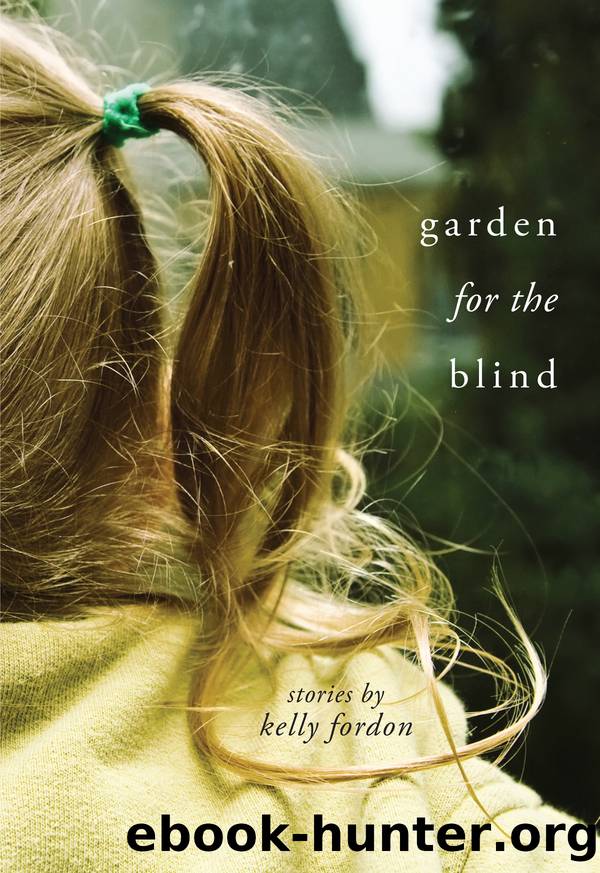Garden for the Blind by Kelly Fordon

Author:Kelly Fordon
Language: eng
Format: epub
Publisher: Wayne State University Press
opportunity cost
2006
My name is David Clarke. For the last two decades I have been a high-school economics and sociology teacher in an affluent suburb outside Detroitâa suburb that has had to work hard to maintain its tenuous air of allure. It is situated along the shores of an idyllic lake and boasts several country clubs, two small shopping âvillages,â and some innocuous architectureâthe homes mostly Tudors and Colonialsâmaking it, in short, a pleasant place to reside.
During the sixties and afterward the city became a volatile territory and relations between the city and the suburbs were strained. My wife, Monica, a treasurer in the local chapter of the Jewish Historical Society and the manager of the Defenders Food Bank, fervently believes that we suburbanites abandoned the city, took our businesses and our money, and turned our backs on city dwellers, impoverishing the area and embittering everyone to boot. Of course, many people disagree with her viewpoint. Nevertheless, I think she is correct in surmising that this legacy will be hard to overcome.
An economics teacher, I believe many variables contributed to the rapid deterioration of this Midwestern region, including but not limited to the death of manufacturing, the inability to efficiently and cost-effectively transfer goods from one location to another, and the extremeâI can hear Monicaâs outrage from here!âdemands of the unions. Add to that environmental and government regulations and cheap labor abroad, and the offshoot is the dive weâre in.
Introduction to Economics is a terminal class at the high-school level, meant to give students a taste of the discipline. My class is always full because itâs an alternative to calculus and many of my students, the sons and daughters of affluent parents, find the practical aspects of the handling, acquisition, and dispersal of money fascinating.
This year we had more girls than boys for the first time in a long time. I also noted that we had two African American students in the class, a girl and a boy. The suburb has slowly become more integrated over the last twenty years, but I would say that even so, less than 5 percent of the student body is black.
On the first day of school, the young man wore khaki pants that had been meticulously ironed if not dry-cleaned, a button-down blue-and-white pin-striped shirt, and loafers with no socks. I noticed his attire because most of the boys at our school wear blue jeans, and the remaining minority favor khakis or cargo pants, most of which are so wrinkled one wonders if theyâve ever been laundered. Almost all of my students wear tennis shoes, so his gleaming penny loafers were as unusual as the briefcase of dark, polished leather he carried.
Everyone filed into the classroom and sat down. On the first day, most students, if given the option, will gravitate to the back of the class. The boy with the pressed khakis was the second person in the room on the first day of school, but instead of putting as much distance between us as possible, he walked straight toward me, held out his hand, and said, âGood morning.
Download
This site does not store any files on its server. We only index and link to content provided by other sites. Please contact the content providers to delete copyright contents if any and email us, we'll remove relevant links or contents immediately.
| Diaries & Journals | Essays |
| Letters | Speeches |
The Rules Do Not Apply by Ariel Levy(4842)
Bluets by Maggie Nelson(4472)
Too Much and Not the Mood by Durga Chew-Bose(4270)
Pre-Suasion: A Revolutionary Way to Influence and Persuade by Robert Cialdini(4142)
The Motorcycle Diaries by Ernesto Che Guevara(4009)
Walking by Henry David Thoreau(3892)
Schaum's Quick Guide to Writing Great Short Stories by Margaret Lucke(3317)
What If This Were Enough? by Heather Havrilesky(3270)
The Daily Stoic by Holiday Ryan & Hanselman Stephen(3228)
The Day I Stopped Drinking Milk by Sudha Murty(3159)
The Social Psychology of Inequality by Unknown(2935)
Why I Write by George Orwell(2874)
Letters From a Stoic by Seneca(2733)
A Short History of Nearly Everything by Bryson Bill(2627)
A Burst of Light by Audre Lorde(2545)
Insomniac City by Bill Hayes(2494)
Feel Free by Zadie Smith(2433)
Upstream by Mary Oliver(2336)
Miami by Joan Didion(2320)
